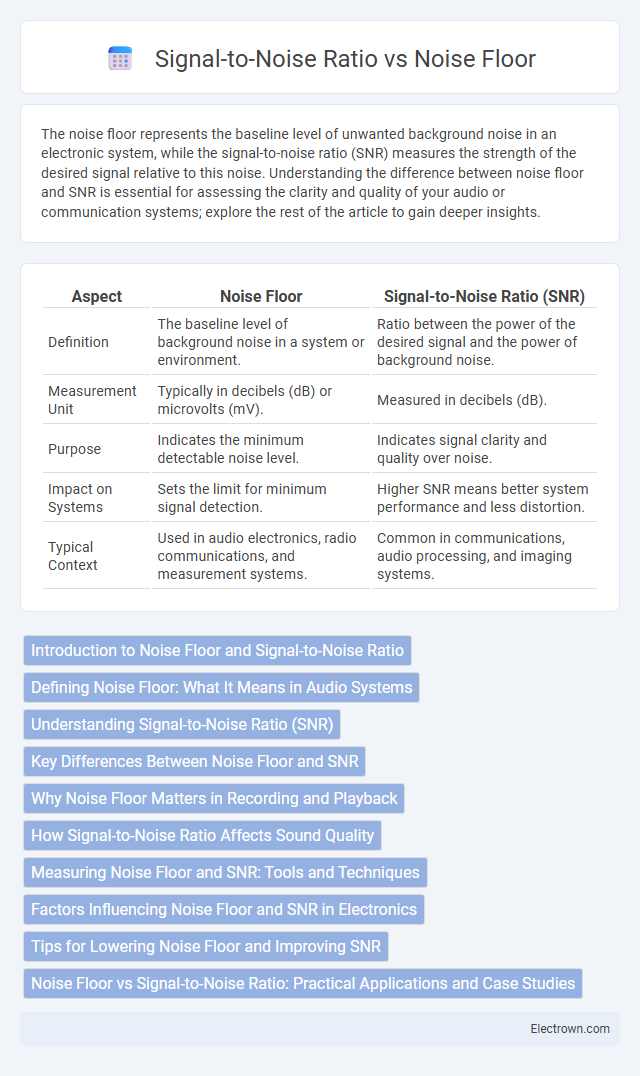The noise floor represents the baseline level of unwanted background noise in an electronic system, while the signal-to-noise ratio (SNR) measures the strength of the desired signal relative to this noise. Understanding the difference between noise floor and SNR is essential for assessing the clarity and quality of your audio or communication systems; explore the rest of the article to gain deeper insights.
Table of Comparison
| Aspect | Noise Floor | Signal-to-Noise Ratio (SNR) |
|---|---|---|
| Definition | The baseline level of background noise in a system or environment. | Ratio between the power of the desired signal and the power of background noise. |
| Measurement Unit | Typically in decibels (dB) or microvolts (mV). | Measured in decibels (dB). |
| Purpose | Indicates the minimum detectable noise level. | Indicates signal clarity and quality over noise. |
| Impact on Systems | Sets the limit for minimum signal detection. | Higher SNR means better system performance and less distortion. |
| Typical Context | Used in audio electronics, radio communications, and measurement systems. | Common in communications, audio processing, and imaging systems. |
Introduction to Noise Floor and Signal-to-Noise Ratio
Noise floor represents the baseline level of unwanted or background noise present in a measurement or communication system, limiting the system's ability to detect weak signals. Signal-to-noise ratio (SNR) quantifies the strength of the desired signal relative to the noise floor, typically expressed in decibels (dB). A higher SNR indicates clearer signal quality, while a noise floor close to or above the signal level reduces system performance and data accuracy.
Defining Noise Floor: What It Means in Audio Systems
The noise floor in audio systems refers to the underlying level of background noise present when no intentional signal is being transmitted. It represents the minimum threshold that distinguishes actual audio signals from unwanted electronic or environmental noise. Understanding your system's noise floor is crucial because it directly impacts the signal-to-noise ratio (SNR), determining the overall clarity and fidelity of audio playback or recording.
Understanding Signal-to-Noise Ratio (SNR)
Signal-to-Noise Ratio (SNR) quantifies the level difference between the desired signal and background noise, measured in decibels (dB). A higher SNR indicates a clearer, more distinguishable signal from the noise floor, which is the minimum detectable signal level in a system. Understanding SNR is essential for optimizing audio quality, telecommunications, and data transmission by ensuring signals remain above the noise floor for accurate reception.
Key Differences Between Noise Floor and SNR
Noise floor refers to the baseline level of background noise present in a system or environment, measured in decibels (dB), while signal-to-noise ratio (SNR) quantifies the strength of the desired signal relative to the noise floor, indicating the clarity of the signal. The noise floor sets the minimum detectable signal level, and a higher SNR means a cleaner, more distinguishable signal from the noise. Key differences include that noise floor is an absolute noise measurement, whereas SNR is a relative measurement expressing the difference between signal and noise levels.
Why Noise Floor Matters in Recording and Playback
The noise floor represents the underlying level of background noise inherent in a recording or playback system, directly impacting the clarity of the audio signal. A lower noise floor allows for a higher signal-to-noise ratio (SNR), ensuring that subtle audio details are preserved without being masked by unwanted noise. In professional audio environments, minimizing the noise floor is crucial for achieving high-fidelity sound reproduction and accurate dynamic range representation.
How Signal-to-Noise Ratio Affects Sound Quality
Signal-to-noise ratio (SNR) directly impacts sound quality by measuring the level difference between the desired audio signal and the background noise, where a higher SNR indicates clearer and more detailed sound reproduction. A low noise floor is essential to achieve a high SNR, minimizing audible hiss and distortion in audio playback. Improving SNR enhances clarity, dynamic range, and overall listening experience by reducing unwanted noise interference.
Measuring Noise Floor and SNR: Tools and Techniques
Measuring noise floor involves using spectrum analyzers and specialized noise measurement equipment to accurately capture the baseline ambient noise level within a system or environment. Signal-to-noise ratio (SNR) is typically measured by comparing the power of the targeted signal against the noise floor using tools such as oscilloscopes with FFT capability, audio analyzers, or software-defined radios (SDRs). Precise measurement techniques include averaging multiple readings and applying filtering methods to isolate signal components, ensuring reliable assessment of system performance in communications, audio processing, and RF engineering.
Factors Influencing Noise Floor and SNR in Electronics
Thermal noise, electromagnetic interference, and component quality are primary factors influencing the noise floor in electronic systems, directly impacting the signal-to-noise ratio (SNR). Lowering the noise floor through shielding, cooling, and using low-noise components enhances the SNR, improving overall signal clarity. Device design, bandwidth limitations, and power supply stability also play critical roles in determining the achievable SNR in various applications.
Tips for Lowering Noise Floor and Improving SNR
Lowering the noise floor involves minimizing electromagnetic interference, using shielded cables, and ensuring proper grounding in audio or communication systems. Improving signal-to-noise ratio (SNR) can be achieved by enhancing the strength of the desired signal through high-quality components, directional antennas, or signal amplification while maintaining or reducing background noise. Implementing digital signal processing techniques such as noise gating and filtering further optimizes SNR for clearer and more reliable signal transmission.
Noise Floor vs Signal-to-Noise Ratio: Practical Applications and Case Studies
Noise floor represents the baseline level of unwanted ambient noise in a system, while Signal-to-Noise Ratio (SNR) quantifies the difference between the desired signal and that noise floor. In practical applications such as audio recording or wireless communication, maintaining a low noise floor enhances the SNR, leading to clearer sound or stronger data transmission. Your ability to optimize both factors directly impacts performance quality, as demonstrated in case studies involving high-fidelity audio systems and advanced radar technologies.
noise floor vs signal-to-noise ratio Infographic

 electrown.com
electrown.com